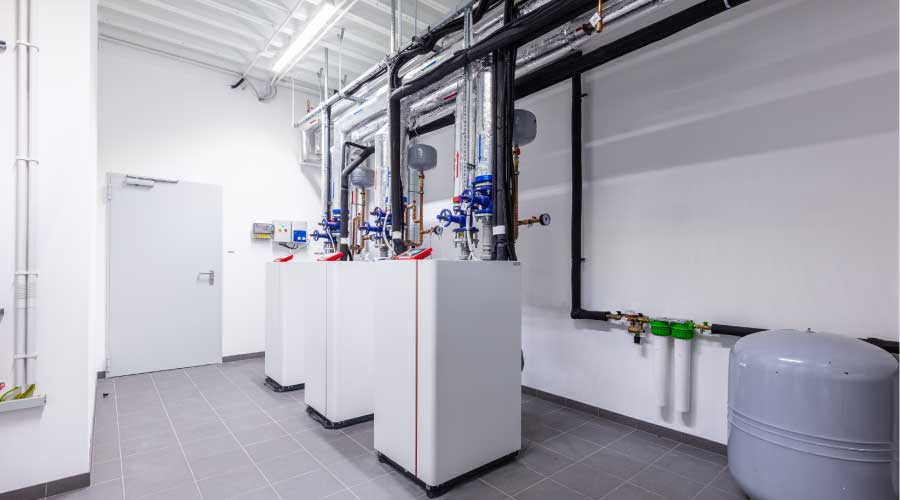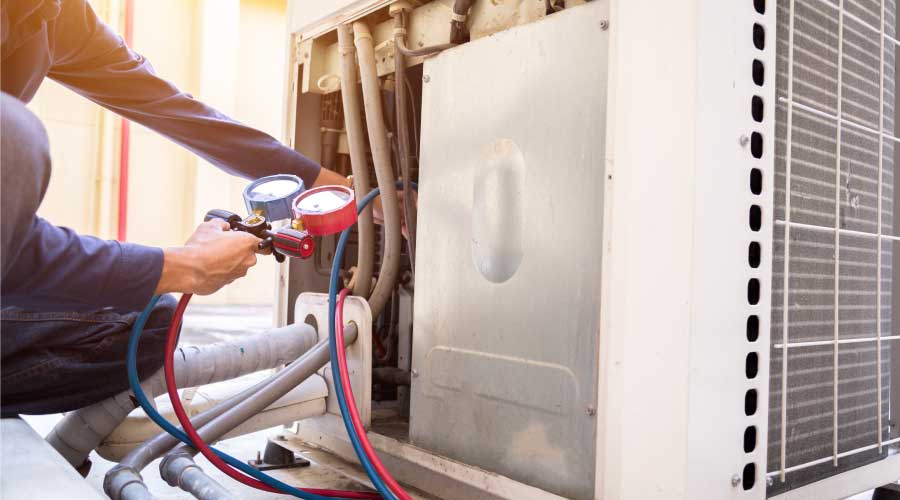Chiller Challenge: Energy Efficiency
A revamped and updated maintenance program can help improve a chiller’s energy efficiency and the return on investment
Chillers are the single largest user of electricity in most commercial and institutional facilities. In many cases, they are the single largest user of any form of energy in buildings. For these reasons, maintenance and engineering managers looking for ways to improve the energy efficiency of their buildings start by improving the efficiency of chillers.
Managers have two primary options to improving chiller performance: replacement and maintenance. Today’s replacement chillers offer managers benefits in both performance and operating efficiency, making any chiller more than 10-15 years old a replacement candidate.
But managers should not enter into chiller-replacement projects lightly. Chillers are big-ticket items, and their installation often disrupts building occupants. And because most types of chillers have service lives of 15-20 years, managers will have to live with their choices for a very long time.
Even the task of selecting the most appropriate chiller for a particular application is not particularly easy. Slight differences between different models can result in rather large differences in the annual energy requirements for cooling a facility. Managers must have enough information to to determine if reduced annual energy costs of one model are enough to justify what might seem like a significant difference in first costs.
A New Efficiency Yardstick
In the past, the most commonly used measure of chiller performance was full-load efficiency rating. Engineers and managers often used the efficiency rating, expressed in kilowatts per ton (kW/ton), to determine the most efficient chiller for a particular application.
While the rating did indicate a chiller’s relative efficiency, it had a serious drawback. It was only valid for a chiller operating at full load. As the load on a chiller falls, so does its operating efficiency. For example, a large centrifugal chiller might have an efficiency rating of 0.50 kW/ton when operating at full load under design conditions. But at half load, the unit’s efficiency might decrease to 0.70 or lower.
Most chillers operate at full load for about 1 percent of their annual operating hours. That means that for 99 percent of a chiller’s operating hours, it operates at less than its full-load efficiency.
This situation creates two problems. First, in making the purchase decision at least in part on different chillers’ full-load operating efficiency, a manager might not have selected the most efficient chiller for the application. Second, estimating a chiller’s annual energy use based on the full-load efficiency rating will result in seriously low estimates.
Managers now have a better estimate of chiller performance that can correct both of these problems. Developed by the Air-conditioning and Refrigeration Institute, the part-load value/application part- load value (IPLV/APLV) is a more realistic value to evaluate chiller efficiency.
The IPLV/APLV rating recognizes that most chiller systems operate below their design ratings for most of the year. As a result, a chiller’s kW/ton efficiency rating is calculated using a complex formula that blends chiller performance at four different design loads: 100, 75, 50 and 25 percent.
The breakdown of hours operated at each of those loads represents what one would expect in the real world. The result is a rating that more accurately reflects what managers can expect in the efficiency of a chiller as it would operate in facilities.
By considering the IPLV/APLV ratings, managers can make better decisions when considering chiller options for both new-construction and replacement projects. They can make more realistic estimates of annual energy costs, as well as more accurate projections of project payback when comparing chillers with different first costs and efficiency ratings.
Managers also should consider the option of equipping existing and replacement chillers with variable-speed drives. Conventional chillers operate at a constant speed. As the load decreases, vanes in the inlet to the compressor close, reducing the chiller’s output. This change also reduces the chiller’s energy use, but the decrease in energy use does not directly match the decrease in the chiller’s output.
A variable-speed drive reduces the output of the chiller by reducing the speed of its compressor. As the chiller speed decreases, so does the compressor’s energy use. When evaluated on an annual basis, the average energy savings produced by the variable-speed drive is about 30 percent, providing a rapid return on the investment.
Maintenance Matters
Purchasing the most efficient chiller is only the first step in minimizing energy costs. Once installed, an organization must maintain the chiller properly if it is to perform as efficiently as possible. In most cases, any savings produced by cutting back on chiller maintenance will be more than offset by increased energy costs.
All chiller maintenance programs start with an operating log. Each day, operators must record chiller-operating parameters, such as refrigerant temperatures and pressures, condenser-water entering and leaving temperatures, and chilled-water entering and leaving temperatures. Operators must review the log regularly and make comparisons with chiller design and start-up data. In doing so, they should identify and investigate deviations in readings, which might indicate a problem within the chiller system that could affect performance and efficiency.
Another critical ongoing maintenance task is properly treating water in both the chilled-water and condenser-water loops to prevent scale, corrosion and biological growth. Any accumulation of these contaminants will result in a rapid decrease in operating efficiency.
The evaporator loop is a closed system. Chemicals typically are added to reach the desired concentration. Beyond that, the only requirement is periodic testing to confirm those concentrations.
In contrast, the condenser-water loop is usually an open loop that includes a cooling tower. As a result, there is an ongoing loss of water from the system, as well as a growing level of contaminants constantly introduced into the system.
Water treatment in condenser-water systems requires an ongoing program of sampling the water and adjusting the feed rates for the various chemicals as required.
Technicians must monitor all chillers for refrigerant leaks. In low-pressure chillers, leaks allow moisture and air to enter the unit. The air and moisture lead to increased operating pressures within the chiller, causing it to use more energy to produce the same level of cooling. Moisture also creates rust within the chiller’s shell, which is transported to and deposited on heat-transfer surfaces within the chiller, further reducing operating efficiency.
Automatic purge units can remove these contaminants from the refrigerant. Technicians should note run times for purge units in the chiller’s daily log. Increasing run times for a purge unit might indicate a developing leak.
In high-pressure chillers, leaks result in lost refrigerant, which in turn leads to lower pressure and operating efficiency. If a chiller is losing refrigerant, operators can identify the location of the leak by tracing the refrigerant circuits using an electronic leak detector.
One feature that has improved energy efficiency of today’s chillers is the performance of heat-transfer surfaces within chillers. But the performance of these surfaces requires that they be clean and free of buildup, including sludge, corrosion, algae, and scale. Even a very thin layer deposited on the surface can result in a significant decrease in efficiency. How quickly they become fouled will depend on the quality of the water in the system, the temperature at which the chiller operate, and the overall condition of condenser and evaporator loops.
To keep these surfaces clean, technicians should clean the condenser tubes annually. Evaporator tubes require cleaning only every three or four years, since they function in a closed system that has limited exposure to contaminants. In most cases, technicians can use brushes to perform the cleaning. But in badly fouled systems, they might need to use chemicals to clean surfaces. Chillers can even be equipped with internal brushes that work in conjunction with reversing valves to brush-clean tubes daily.
At least once each year, operators should take oil and refrigerant samples. These samples will indicate developing problems and conditions, such as corrosion or high moisture content. These tests are among the best indicators of a chiller’s overall condition.
While these tasks represent the major items that will help managers ensure a chiller’s maximum operating efficiency, they are not the only ones operators must perform. Every chiller manufacturer provides operators with a schedule of maintenance activities they also must perform.
While these schedules are comprehensive, managers should consider them to be the minimum requirements for the chiller. Equipment that serves critical loads will require additional maintenance efforts in order to maintain the desired levels of reliability and performance.
Similarly, chillers will require additional maintenance attention if they are to operate at their highest possible efficiency.
James Piper, P.E., is a national consultant based in Bowie, Md., with more than 25 years of experience with facilities maintenance and engineering issues.
Related Topics:











